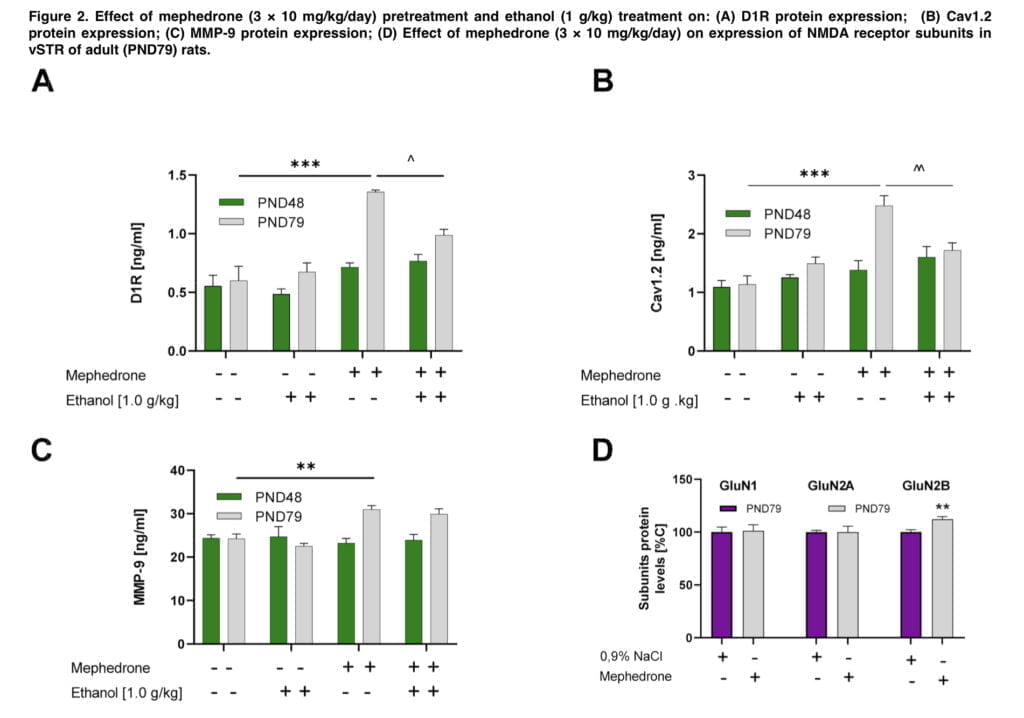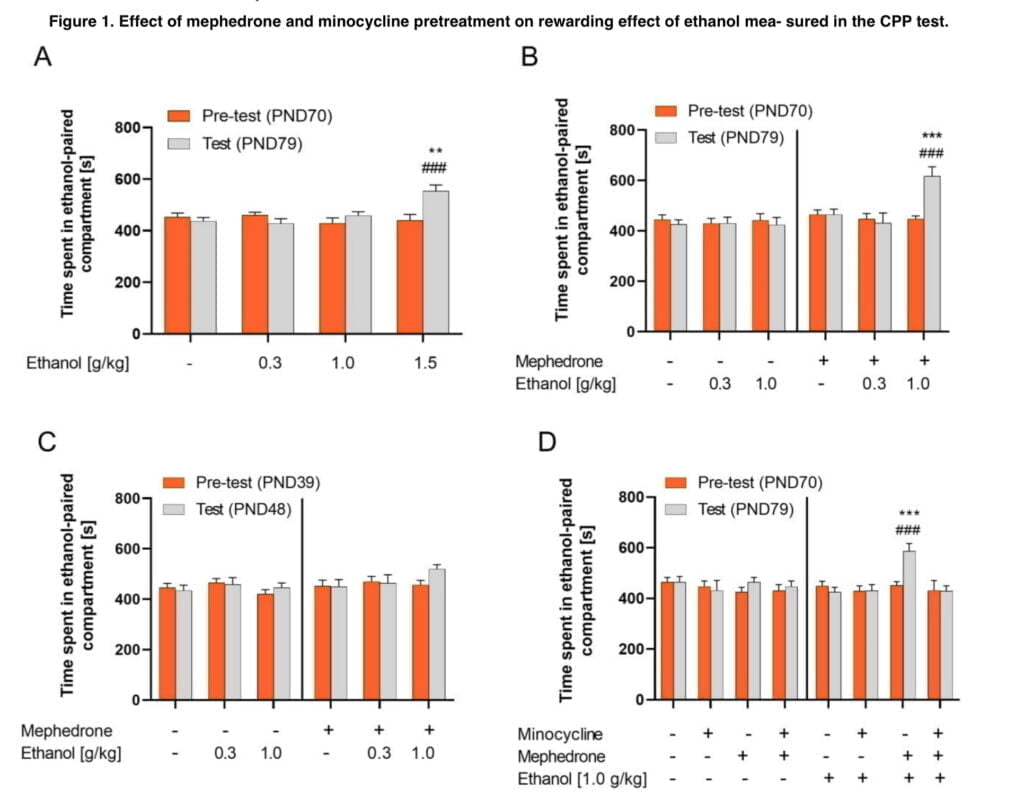According to published statistics, the majority of mephedrone users initially consume “large” amounts of alcohol before using the drug, and then they gradually cut back when the drug’s effects are felt. According to a different research, polydrug users frequently combine mephedrone with alcohol. This combination of psychoactive substances produces greater feelings of euphoria and well-being than taking one of these substances alone. Another study has found that those who have recently used stimulants like cocaine or amphetamine seem to be more susceptible to the stimulant effects of ethanol than people who have never used them. Such an effect is specific to stimulant users, and this was not observed after using cannabis or hallucinogens. It is, however, not clear whether more intense ethanol rewarding effects are observed in past-year mephedrone users.
The main component of the ventral striatum is the accumbens nucleus. Also, this area of the brain can be classified as a key structure involved in mediating emotional processes, libido-motor interaction, and the effects of some psychoactive substances. Addiction-inducing substances increase dopamine (DA) release in the NAc, which activates dopamine D1 and D2 receptors (D1R and D2R), which may control motivation for rewards. Mephedrone increases DA levels in the NAc, striatum, and frontal cortex in rats and inhibits the reuptake of DA in the mesolimbic structures, including the NAc. Mephedrone also inhibits DA transporter (DAT) in a dose-dependent manner and prevents in vitro DA re-uptake through vesicular monoamine transporter-2. Consequently, following mephedrone administration, a rise in extracellular DA levels is expected to cause abnormal DA signaling and stimulant-related behaviors. Ethanol is also able to increase burst firing of DA neurons in the NAc by direct or indirect mechanisms.
Extracellular matrix (ECM) proteins, which serve as the structural framework for the cells around them, may be broken down by a family of proteolytic enzymes called matrix metalloproteinases (MMPs), allowing for the reconfiguration of neural circuits. MMP-9’s capacity to regulate synaptogenesis, axonal pathfinding, and myelination allows it to manage local circuit reconfiguration throughout development. MMP-9 is hypothesized to contribute to adult neurogenesis and synaptic plasticity in the adult brain. Some publications have reported dysregulation of MPP-9 activity after mephedrone use. Additionally, studies have shown that MMPs, namely MMP-2 and MMP-9, are activated and function in such aspects of addiction including motivation in mice and people, the rewarding impact, or relapse/reinstatement in rats.

In the current study, we examined whether past binge mephedrone treatment during adolescence affects ethanol reward using the conditioned place preference (CPP) paradigm. Additionally, we examined whether age and MMP- 9 are important in this regard. In rodents, “adolescence” is considered as the period from postnatal day (PND) 25 to PND 60, which corresponds to early adulthood Myelination, synaptic fine-tuning, and brain maturation are characteristics of adolescence. All of these elements increase the teenage brain’s sensitivity to drug abuse’s harmful consequences and may result in substance use disorders. The current study also intended to ascertain if mephedrone-induced alterations in the ethanol reward might be mitigated by minocycline, an inhibitor of MMP-9 activity. We evaluated the amount of MMP-9 and the expression of the D1 receptor and Cav1.2 following mephedrone and/or ethanol treatment in the vSTR, in the present study using a set of biochemical assays in adolescent and adult rats. In addition, we examined the expression of NMDAR subunits (GluN1, Glu2A, and Glu2B) in adult rats’ vSTRs following the injection of binge-like mephedrone in adolescence.
Methods and materials used for the study
- The present experiment was conducted on male rats that weighed 100-135 grams at the first stage of the study. The dose of mephedrone hydrochloride was 10 mg/kg, and the substance was injected intraperitoneally three times a day. Minocycline with proven neuroprotective properties was administered intravenously once a day at a dose of 45 mg/kg, immediately before the morning injection of mephedrone. The above substances were administered for seven days.
- The CPP paradigm consisted of four phases that lasted for 11 consecutive days: habituation, pretest, conditioning, and test. In order to divide the rats into their respective groups, the time the animal spent in each compartment was measured.
- After a seven-day course of substance injections, rats were divided into two cohorts: in the first cohort, animals underwent the CPP procedure at PND38, pre-test (PND39), conditioning (PND40-47) and test (PND48); animals in the second cohort underwent the procedure starting at PND69. The animals were beheaded once the ethanol CPP test was finished, and the brain regions were taken out and frozen for further neurochemical examinations.
- In order to evaluate the involvement of MMP-9 in the effects caused by mephedrone, animals were given minocycline (an MMP-9 inhibitor) at a dose of 45 mg/kg during mephedrone administration or every day before the first injection of the substance. The CPP procedure was performed according to the standard method, but only one dose of 1 g/kg ethanol was given during conditioning. After the procedure, the brain structures were subjected to biochemical analysis.
- An ELISA assay was performed to identify the quantification of MMP-9, D1R and Cav1.2.
- To evaluate NMDAR subunits, we used a western blot.
Description and discussion of the results
For the first time, the current study shows that adult rats that have previously used mephedrone exhibit a more potent ethanol-induced CPP than their teenage counterparts. When minocycline, an MMP-9 antagonist, was administered before mephedrone injection, the mephedrone effect was not noticed in adult rats. Along with these behavioral alterations, we noticed that adult but not adolescent rats who had previously taken mephedrone had significantly increased D1R, Cav1.2, and MMP-9 expression in the vSTR. Moreover, adult rats who had previously received mephedrone treatment showed elevation of the GluN2B subunit of NMDAR. In adult rats that had received mephedrone in adolescence, ethanol treatment during the conditioning sessions decreased the upregulation of D1R and Cav1.2 but had no effect on the MMP-9 level. These findings collectively imply that mephedrone therapy in the past differed changed ethanol’s rewarding effects in adolescent and adult rats.
Contrary to a prior study that suggested former stimulant users are more susceptible to the rewarding features of ethanol, the CPP response in adolescent but not adult rats. Sadly, we did not evaluate the dose-effect relationship for ethanol CPP in young rats. However, we presumptively observed a changed dose-effect curve in adolescence. As a result, our study implies that adult rats that had previously received mephedrone treatment may require greater doses of ethanol to get the same reaction as young rats. If these findings were applied to people, it is feasible that teenage mephedrone users, like teenage MDMA users, may be more likely than adults to acquire ethanol addiction-related behaviors. Furthermore, due to enhanced reward experience, adults most likely chase the drug and develop addictive behaviors faster than adolescents.
As we observed a substantial CPP in adult rats with prior mephedrone experience but not in teenage rats, prior mephedrone exposure had no effect on the motivational valence of the setting in adolescents but that it boosts it in adults. The CPP expression, on the other hand, is a representative of the memory retrieval of the conditioned response that is acquired due to pairing of the subjective effects of the drug and the context during conditioning. When mephedrone has previously been administered to adult rats, this reaction is stronger than it is in adolescent rats. It indicates that past mephedrone exposure may differentially cause molecular alterations, leading to these behavioral abnormalities, even though we had anticipated seeing a bigger reaction in teenage rats. These findings imply that teenage exposure to mephedrone, like adolescent exposure to amphetamines, may generate long-lasting neurophysiological modifications (remodeling) that affect the behavior of the individual.

A crucial step in the process of a drug’s rewarding and reinforcing effects is the release of DA in the NAc. We examined the NAc D1R expression in the vSTR of adult and adolescent ethanol-conditioned rats with/without previous mephedrone injection since this receptor is primarily implicated in the acquisition of ethanol-induced CPP. We discovered that during the CPP test, ethanol alone had no discernible effect on the expression of D1R and L-type Cav1.2 channels in the vSTR of juvenile or adult rats. However, adult rats who had previously received mephedrone therapy had a substantial increase of D1R. This mephedrone effect was accompanied by an upregulation of L-type Cav1.2 channels expression. These results show that adults who had previously used mephedrone were more susceptible than teenagers to the rewarding effects of ethanol on the dopamine system. Therefore, in the mice that had previously received mephedrone, even a little ethanol-induced shift or increase in extracellular dopamine was enough to inhibit the elevation of D1R and Cav1.2 expression. These results show that ethanol exposure during adolescence can/does result in less strong dopamine responses than ethanol exposure does throughout adulthood.
The results of data analysis regarding the effect of minocycline showed that it does inhibit the expression of MMP-9 in the vSTR (Figure 1). In the present study, ethanol had a less rewarding impact on adult rats when minocycline was administered before mephedrone injection in adolescence. Furthermore, our results show that binge mephedrone administration throughout adolescence increased MMP-9 expression in the vSTR in adult but not in adolescent rats. With the help of these findings, we came up with the hypothesis that mephedrone therapy during adolescence differently impacted MMP-9 expression in rat populations of adult and adolescent.
Our results show that binge mephedrone use throughout adolescence significantly changed the level of MMP-9 in adult (PND79) but not adolescent (PND48) rats. These findings support our earlier observations that MMP-9 expression was significantly upregulated after a delay of 14 days and for up to 38 days following the last mephedrone injection, suggesting that MMP-9 may play a role in subsequent processes. According to published evidence, synaptic plasticity is influenced by neuromodulation through the D1-type dopamine receptor, which particularly induces ECM proteolysis via NMDAR/NR2B activation and intracellular calcium signaling. We thus postulate that such a mechanism may have been at work in our investigation of adult rats who had previously received mephedrone. Future research, however, will be required to fully understand how ethanol CPP affects the expression of NMDAR subunits in rats that have previously been exposed to mephedrone.
Conclusion
In conclusion, our findings imply that binge-like mephedrone injection during adolescence sensitized adult rats to the rewarding effects of ethanol but not adolescent rats. In adult rats, these changes are associated with the upregulation of D1R and NMDAR/Glu2B, as well as upregulation of L-type of calcium channel and MMP-9 expression in the vSTR. Because susceptibility to the ethanol reward is inhibited when MMP-9 activity is blocked by minocycline, it seems that MMP-9 activation was the origin of these neuroplastic alterations in reward circuits. The decrease in the ethanol rewarding action in adolescents, compared with adult rats, may suggest that this may be one cause of the dose escalation in chasing pleasure in this population. In turn, adults with prior mephedrone exposure more rapidly develop addictive behavior than adolescents.
